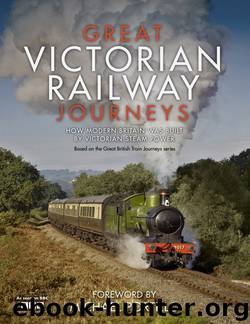Great Victorian Railway Journeys by Karen Farrington

Author:Karen Farrington
Language: eng
Format: epub
Publisher: HarperCollins Publishers
© Motoring Picture Library/Alamy
The Hon. Evelyn Ellis in his Panhard-Levassor, 1895.
© Peter Titmuss/Alamy
Bodmin, a steam locomotive pulling on the Watercress Line.
The trip was more daring than it first appears. There were of course no petrol stations, so the oil they bought was from a chemist’s shop. But Ellis and Simms were also flouting the law, which decreed motorised vehicles could only use the roads if a man walked in front waving a red flag. This law was repealed the following year. Still, on its early performance there was little to suggest that the motor car would have overwhelmed the train in terms of popularity and usage within a century.
It would be decades before road transport made it impact on industry in Britain. In the meantime, businesses that relied on getting produce to consumers in timely fashion were flourishing, as the railway network continued to expand.
The watercress business fell into this category, and its success contributed to an improvement in the general health of Victorian society. Watercress was favoured by rich and poor alike. Children would pluck bunches of the naturally occurring vitamin-rich plant to eat in the hand. Aristocrats enjoyed it as it garnished silver-service meals on porcelain plates. Its health benefits were immense, as it contains iron, calcium, sulphur and other nutrients.
Watercress was first farmed in Britain at the beginning of the nineteenth century. Hampshire soon became a centre of the trade as crops flourished in the chalky waters of its rivers. Before trains reached the county, stagecoaches were used to transport it to London. When the county was finally fractured by rail services, the one serving the heart of the industry was nicknamed ‘the watercress line’. It was built between the existing stations at Alton and Winchester and was officially called the Mid-Hants Railway after it opened in 1865. The stations on the line were Itchen Abbas, Ropley and Alresford. Another station, Medstead and Four Marks, was opened three years later. After willow flats or hampers filled with watercress were loaded onto the trains, they were taken to London and then across Britain for the watercress to be sold as a low-cost snack. Always a secondary line as far as the railway authorities were concerned, the Mid-Hants Railway nevertheless attracted interest for combating some severe gradients, ascending at its highest point to 652 ft (199 m) above sea level.
When the railway line linking Winchester and Southampton was built in 1838 by the London & South Western Railway, Winchester was its temporary terminus. Eventually tens of thousands of visitors used the train to wonder at the ancient glories in the Roman city. Bradshaw’s describes how one of the first organs made in England was installed in Winchester’s cathedral in the year 951. ‘It was a ponderous thing containing 400 pipes blown by 24 pairs of bellows.’ In 1854 the organ was replaced by one that had thrilled visitors to the Great Exhibition three years earlier, with 5,500 pipes.
At first, Winchester was the only major centre of population on the London to Southampton line, with Basingstoke a minor market town.
Download
This site does not store any files on its server. We only index and link to content provided by other sites. Please contact the content providers to delete copyright contents if any and email us, we'll remove relevant links or contents immediately.
Whiskies Galore by Ian Buxton(41731)
Introduction to Aircraft Design (Cambridge Aerospace Series) by John P. Fielding(33024)
Small Unmanned Fixed-wing Aircraft Design by Andrew J. Keane Andras Sobester James P. Scanlan & András Sóbester & James P. Scanlan(32695)
Aircraft Design of WWII: A Sketchbook by Lockheed Aircraft Corporation(32174)
Craft Beer for the Homebrewer by Michael Agnew(18088)
Turbulence by E. J. Noyes(7904)
The Complete Stick Figure Physics Tutorials by Allen Sarah(7275)
The Institute by Stephen King(6870)
Kaplan MCAT General Chemistry Review by Kaplan(6833)
The Thirst by Nesbo Jo(6770)
Bad Blood by John Carreyrou(6495)
Modelling of Convective Heat and Mass Transfer in Rotating Flows by Igor V. Shevchuk(6361)
Learning SQL by Alan Beaulieu(6170)
Weapons of Math Destruction by Cathy O'Neil(6091)
Man-made Catastrophes and Risk Information Concealment by Dmitry Chernov & Didier Sornette(5884)
Permanent Record by Edward Snowden(5691)
Digital Minimalism by Cal Newport;(5593)
Life 3.0: Being Human in the Age of Artificial Intelligence by Tegmark Max(5411)
iGen by Jean M. Twenge(5335)
